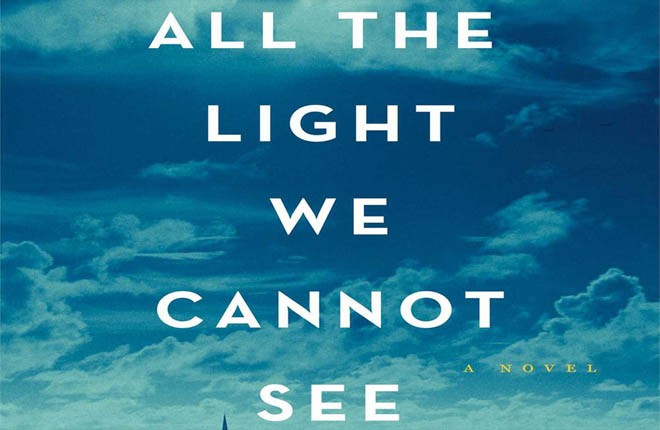
The novel is wholly concerned with portraying the humanity in every single being that populates it

All The Light We Cannot See is a lyrical masterpiece that pivots two riveting narratives around real life events of World War II. It is the tale of an enchanting, young, blind Parisian girl named Marie-Laure and Werner Pfennig, an impoverished German orphan who finds an escape from a mining complex in the Nazi-run National Political Institute of Education.
The novel is intriguing because of its non-linear narrative, with the plot skipping back and forth between days, weeks and at times even decades. From the first page, Anthony Doerr takes us to the coastal town of Saint Malo, which is on the precipice of being bombed by American planes to end Nazi occupation. However, soon the plot lurches back in time, before Marie-Laure lost her sight. One moment, the reader is consumed in a moving and nostalgic chapter on how Marie-Laure’s father teaches her to navigate the complicated streets and intersections in their neighbourhood and the very next chapter dwells on the rise of the Reich and abject poverty deep in German hinterland. We are allowed glimpses into the life of Werner who is on the brink of discovering his exceptional talent for science. Marie-Laure’s whimsical and other worldly story is contrasted against Werner’s grim and uncertain life.
Perhaps the book’s biggest accomplishment is the breadth of its subject matter. Doerr’s tale undertakes topics as varied as mechanical and technical science because of Werner’s obsession with radios, and Hitler’s policy of stamping out any dissidence by controlling radio broadcasts. Doerr also ventures to the natural world through Marie’s fascination with mollusks and the Museum of Natural History where her father works and her ability to read the world through sensory cues; and by describing to us the magical, fabled properties of gem stones, coal and one diamond in particular.
The ‘sea of flames’ is a stone of brilliant blue with "a touch of red at its centre, like flames inside a drop of water," and is a recurring motif that ultimately brings together Marie-Laure and Werner’s storylines. The invaluable stone is hotly pursued by the Nazi Sergeant Major von Rumpel, who has been entrusted with the task of collecting treasures from across Europe for a museum Hitler envisioned. The accursed stone is first mentioned to Marie-Laure when she is on a children’s tour of the Museum of Natural history in Paris. "The curse was this: the keeper of the stone would live forever, but as long as he kept it, misfortunes would fall on all those he loved one after another in ending rain," warns the tour guide.
The novel is wholly concerned with portraying the humanity in every single being that populates All The Light. The very name of the novel is a nod to the invisible light we cannot see, such as wavelengths of the electromagnetic spectrum that are undetectable to the naked eye, but allow us to experience a different world enabled by radio waves. It is over the radio that Werner hears a transmission regarding science: "So how, children, does the brain, which lives without a spark of light, build for us a world full of light?" asks the Professor on the radio, whom we later learn is Marie-Laure’s great uncle. This is merely one of the many surprising connections between the protagonists.
Despite the fact that Doerr received the Pulitzer Prize for Fiction in 2015 for this work critics have had much to say. For one, the non-traditional approach of arranging the timeline has been described as ‘jarring’ and ‘ragged’; admittedly, at times it was challenging to keep up with. However, the overall book is broken down into distinct time frames no longer than four or five pages per chapter. This was deliberately designed as a respite from all the lyricism in the 530 pages over which this story unfolds. Doerr’s style is reminiscent of Charles Dickens in his book David Copperfield, a treasured book I came upon as a child and read many times over. Doerr’s sentences are a labour of love, dotted with visual and articulate descriptions such as "Darkness falling like velvet," but on occasion they tend to become overkill.
One particular criticism stands out: the contention that Doerr engages in relativising and aestheticising the events of World War II by diminishing the moral implications of the Nazi regime. It is alleged that by heightening the sentimentality of the narrative, Doerr minimises the realistic perspective of how events actually unfolded. This, of course, is a difficult issue to resolve, and perhaps a risk Doerr willingly undertook as he spent a 10 years researching and planning this book. Whether he has done justice to the horrors of war and irreparable harm suffered by hundreds of thousands remains up for debate, but in Doerr’s own words, "My attempt in this novel is to suggest the humanity of both Werner and Marie-Laure, to propose more complicated portraits of heroes and villains; to hint at, as World War II fades from the memories of its last survivors and becomes history, all the light we cannot see."